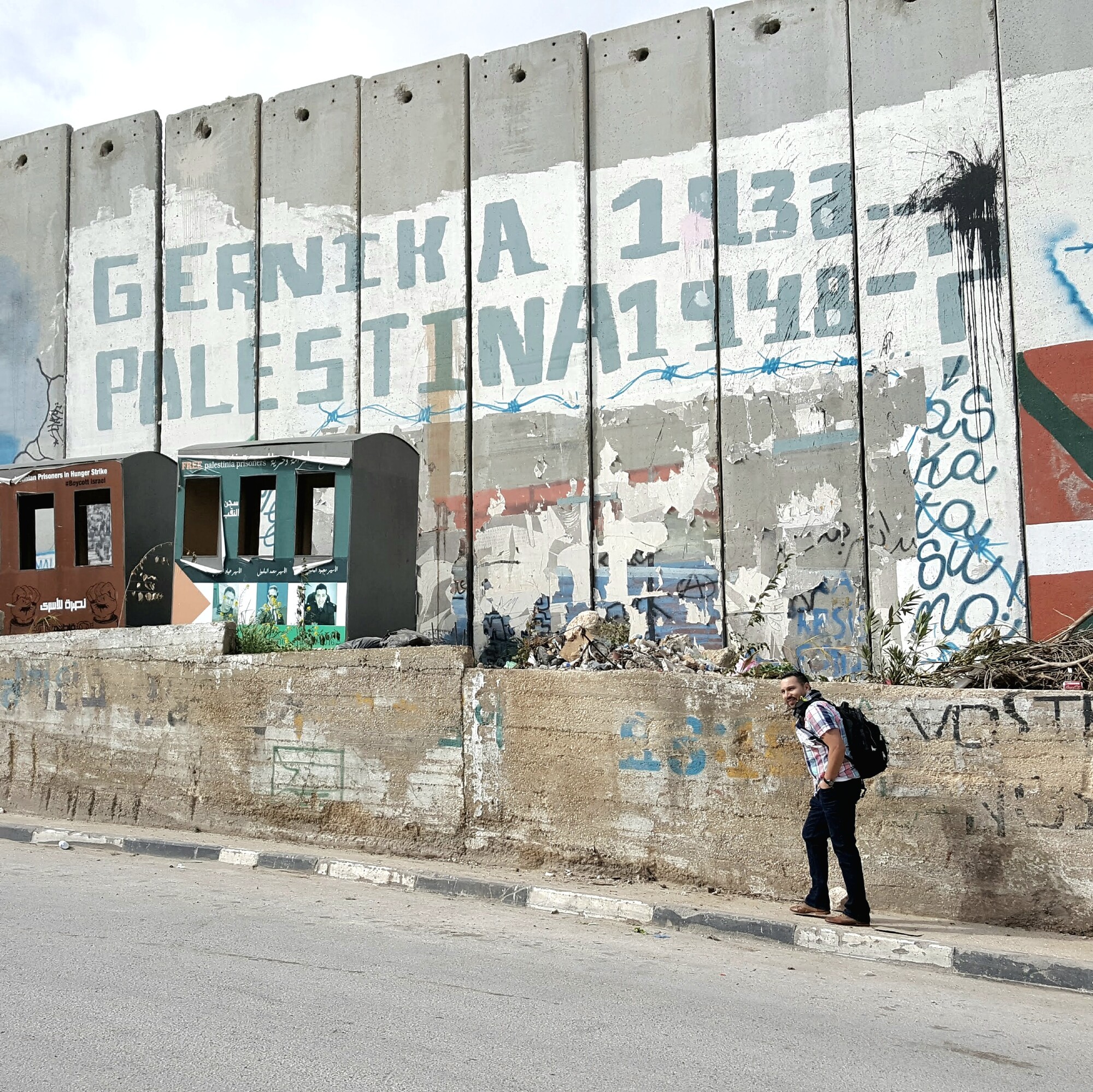Seeking peace in Palestine and Israel through people-to-people connections

In 2015, when a resolution called “Seeking Peace in Israel and Palestine” was proposed at the Mennonite Church USA convention, I watched how many of my Latino and Latina brothers and sisters went to the microphone to express their support for Israel. I was not surprised. I knew exactly where their convictions came from.
I grew up in Guatemala in evangelical and Pentecostal churches. Our songs, Sunday school teachings and sermons were filled with Christian Zionist theology that declares God’s will to be the establishment of a Jewish homeland in Palestine, and the duty of Christians to support Israel. Some churches even display an Israeli flag in their sanctuary.
The songs I learned as a child were about the God of the armies of Old Testament Israel. In that congregation, as in later evangelical and Hispanic Mennonite congregations in Calgary, Alberta, and then in Goshen, Indiana, our worship included songs about the God of Israel who cuts the heads off our enemies. Our readings were primarily from the Old Testament which depicted violence and genocide. In our worship we celebrated the deaths of the enemies of Israel.
It is of no surprise to me that many who come from similar theological frameworks do not question the actions of the Israeli government in this current moment. They see the state of Israel as a David coming up against a Goliath, believing that Israel continues to be the little biblical nation it once was amid empires, and not the world superpower it is now.
I remember as a child that some of my family members who owned guns would celebrate and show them off every time they acquired a gun made in Israel. It was as if they were holding David’s slingshot. I was taught to believe that the nation and state of Israel were the people of God – no questions asked. It was sinful to question this belief. I did not understand the nuances, history or political implications.
Body
I learned that the Bible is not flat. There is a mountain in the gospels, where we stand with Jesus and can see and understand the rest of the Bible—Old and New Testaments—through his teachings, vision and mission.
I held that Zionist vision of Israel for most of my life. That is, until I studied history and theology at Goshen College in the Hispanic Ministries program. Theology professors such as Juan (John) Driver and Ron Collins were instrumental, patient enough to help me deconstruct these violent narratives and reconstruct a new Anabaptist peace theology with a different vision of God, Jesus and Israel. A new eschatological vision. I learned that the Bible is not flat. There is a mountain in the gospels, where we stand with Jesus and can see and understand the rest of the Bible—Old and New Testaments—through his teachings, vision and mission.
So, when the “Seeking Peace in Israel and Palestine” resolution was proposed at the Mennonite Church USA convention in 2015, and my Hispanic/Latino(a) brothers and sisters opposed it, I knew what was happening. I knew exactly where that opposition came from. In that instant, I decided to join the “Come and See” Israel-Palestine Working Group, which was composed of various Anabaptist agencies and organizations.
The objective of the working group was to educate leaders in our denomination about Palestine and Israel and to join a learning tour of the Holy Land which included a visit to both Israel and the occupied Palestinian territories. The proposal was to send 100 leaders. The goal was exceeded. More than 110 Mennonite leaders signed up, including most of my Hispanic/Latina(o) brothers and sisters who I saw walk to the microphone that day in Kansas City.
As we extended the invitation, some stated, “I am pro-Israel and will not change my mind.” For some, even on the learning tour, that narrative persisted for a few days. But that mindset was challenged as we listened to stories from people on both sides of the Israeli separation wall and as they witnessed the oppression that Palestinians are experiencing.
Quote
As we extended the invitation, some stated, “I am pro-Israel and will not change my mind.” For some, even on the learning tour, that narrative persisted for a few days. But that mindset was challenged as we listened to stories from people on both sides of the Israeli separation wall and as they witnessed the oppression that Palestinians are experiencing.
As we passed through Israeli immigration and customs, one woman was held for interrogation. She had been so excited and joyful as we landed. But when she came out of the immigration and customs area, she was almost in tears. We, Latinas(os), share some physical features with ethnic groups in the Middle East (I was constantly asked if I was Lebanese). From that moment on, we felt the tensions and racial segregation. Three days into the learning tour, the African American woman in our group wanted to return to the U.S. She felt unsafe, referencing the Jim Crow times in the U.S.
In addition to visiting the typical Christian “holy sites,” we went behind the walls which very few visitors cross. We walked through checkpoints, reminding us of the challenges undocumented members of our congregations face in the U.S. We visited Palestinian refugee camps and Israeli settlements. We enjoyed the hospitality of Christian Palestinian sisters and brothers near Bethlehem, and listened to stories from Jews, Christians and Muslims alike. At Bethlehem Bible College, we learned about the complex Christian theological perspectives on the land.
We planted olive trees in the West Bank, near Israeli settlements built against international law. The settlers wanted to displace the Christian Palestinian farmers. Due to Israeli laws stipulating that uncultivated land can be taken by the government, planting trees and keeping the land productive was necessary to keep the land in the hands of these families who have lived and farmed the lands for generations. We learned that the conflict is not Muslim-Jewish, or Jewish-Palestinian, it is between the State of Israel and anyone who opposes the expansion of its occupation – in some cases, even against Jewish people of conscience who oppose the illegal expansion and displacement of Palestinians.
Quote
We learned that the conflict is not Muslim-Jewish, or Jewish-Palestinian, it is between the State of Israel and anyone who opposes the expansion of its occupation – in some cases, even against Jewish people of conscience who oppose the illegal expansion and displacement of Palestinians.
By the end of our Come and See learning tour, we were not able to consider the single story of our Christian Zionist upbringings anymore. Our belief system and theology had been changed. Most of our leaders who had claimed unwavering support for Israel started to speak out about Palestine and Israel. No longer could they speak about it as a one-sided narrative.
As a result, at the Mennonite Church USA convention in 2017, Hispanic Mennonite and People of Color leaders were some of the first to approach the microphone to speak in support of the Seek Peace resolution. We did not forget about the people or the land of Israel. But our new narratives held the complexity of the stories we heard and of the shared humanity of Palestinians and Israelis. We committed to read and study The Kairos Document put together by our Christian brothers and sisters in Palestine and Israel. We committed to speak out!
As we witness the atrocities of the recent violence in Israel, Gaza and the West Bank, I am reminded of that commitment. The invitation here is simple: For those of us who visited Palestine and Israel during the Come and See tours, this is the time to share and talk about our experience. Pull out your photos, notes and souvenirs. Speak with your congregation, family and friends.
Quote
This is the time to use our Christian political leverage to call for a permanent ceasefire and a just resolution to the conflict.
This is the time to use our Christian political leverage to call for a permanent ceasefire and a just resolution to the conflict. This is the time to embrace complexity in a world where media often simplifies narratives, promotes misinformed stories and fuels conflict. This is another moment to relentlessly seek peace.
Learn more. Explore MCC and Palestine and Israel: Commonly asked questions. See the Mennonite Church USA video “Seeking Peace in Israel and Palestine Resolution” which highlights the impact of the learning tours.
Saulo Padilla is migration education coordinator for MCC U.S. National Peace & Justice Ministries.
Header photo caption: Saulo Padilla walks by the Israel separation wall in 2017 at Aida (Ayda), a Palestinian refugee camp situated north of Bethlehem in the West Bank, Palestine, established in 1950 by refugees from Hebron and the Jerusalem areas. MCC Photo/Saulo Padilla

